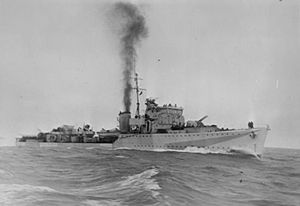
The first HMS Montrose was one of eight Admiralty-type destroyer leaders, sometimes known as the Scott class. They were named after figures from Scottish history; Montrose was named for the Graham Dukes of Montrose. She was built during the First World War, but was completed too late for service then. However, she had a long career in the inter-war years and saw extensive service during the Second World War.

HMS Jervis, was a J-class destroyer of the Royal Navy named after Admiral John Jervis (1735–1823). She was laid down by R. and W. Hawthorn, Leslie and Company, Limited, at Hebburn-on-Tyne on 26 August 1937. The ship was launched on 9 September 1938 and commissioned on 8 May 1939, four months before the start of the Second World War.

HMS Exmoor was a Hunt-class destroyer of the Royal Navy. She was a member of the first subgroup of the class, and saw service in the Second World War, before being sunk by German E-boats in 1941.
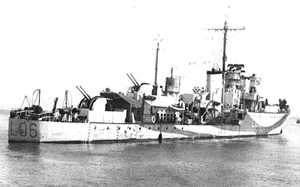
HMS Avon Vale(pennant number L06) was an escort destroyer of the Hunt Type II class. The Royal Navy ordered Avon Vale's construction three days after the outbreak of the Second World War. John Brown Shipbuilding & Engineering Company Ltd laid down her keel at their Clydebank yard on 12 February 1940, as Admiralty Job Number J1569. After a successful Warship Week national savings campaign in February 1942, Avon Vale was adopted by the civil community of Trowbridge, Wiltshire.

HMS Tynedale was a Hunt-class destroyer of the first subgroup which served during the Second World War. She was sunk by the U-593 on 12 December 1943.

HMS Ekins (K552) was a British Captain-class frigate of the Royal Navy that served during World War II. Originally constructed as a United States Navy Buckley class destroyer escort, she served in the Royal Navy from 1943 to 1945.
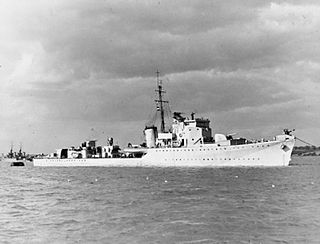
The second HMS Hambledon was a Hunt-class destroyer of the Royal Navy in commission from 1940 to 1945. She was a member of the first subgroup of the class, and saw service throughout World War II.
HMS Blencathra (L24) was a Hunt-class destroyer of the Royal Navy in commission from 1940 to 1948. She was a member of the first subgroup of the class, and saw service through most of World War II.

HMS Vivacious (D36) was a V-class destroyer of the British Royal Navy that saw service in World War I and World War II.

HMS Versatile (D32) was an Admiralty V-class destroyer of the British Royal Navy that saw service in World War I, the Russian Civil War, and World War II.

The third HMS Windsor (D42) was a W-class destroyer of the British Royal Navy that saw service in the final months of World War I and in World War II.

HMS Wolsey (D98) was a W-class destroyer of the British Royal Navy that saw service in the final months of World War I, in the Nanking incident of 1927, and in World War II.

The eighth HMS Worcester, was a Modified W-class destroyer of the British Royal Navy that saw service in World War II. She later served as an accommodation ship as the second HMS Yeoman.

HMS Albrighton was a Type III Hunt-class destroyer built for the British Royal Navy. She entered service in February 1942, first carrying out an attack on German ships in the English Channel then taking part in the Dieppe Raid, rescuing survivors from the sinking destroyer HMS Broke. Albrighton was next assigned to search for and destroy the German auxiliary cruiser Komet, then escorted a convoy to Gibraltar in prevision of the Allied landings in North Africa. Between December 1942 and April 1943, she participated in the sinking of three more Axis ships with the First Destroyer Flotilla. During the Normandy Landings in June 1944, Albrighton served as a headquarters ship, then sank two German trawlers in the weeks after the invasion. After being converted to a destroyer in early 1945, she was damaged in a collision with a Landing Ship, then was assigned to the British Eastern Fleet. However, the war ended before she was deployed and Albrighton went into reserve.

HMS Brocklesby was a Type I Hunt-class destroyer of the Royal Navy. She served during the Second World War, spending much of the time in the English Channel and Mediterranean, taking part in the Dieppe Raid in 1942, and the Allied landings in Sicily and at Salerno in 1943. After the war, she was used as a sonar trials ship until 1963, and was sold for scrap in 1968.

HMS Cattistock (L35) was a Type I Hunt-class destroyer of the Royal Navy. She was a member of the first subgroup of the Hunt class and served throughout World War II before being scrapped in 1957.
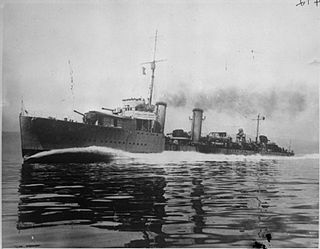
HMS Mackay was an Admiralty type, sometimes known as the Scott class, flotilla leader of the British Royal Navy. Mackay was built by Cammell Laird during the First World War, but was completed too late for service then, commissioning in 1919.

HMS Campbell was an Admiralty type flotilla leader of the British Royal Navy. Built by Cammell Laird, Douglas commissioned in December 1918, just after the end of the First World War. During the Second World War, Campbell mainly served with as a convoy escort, particularly on the East Coast of the United Kingdom. She survived the war, and was sold for scrap in 1947.
HMS Talybont was a Type III Hunt-class escort destroyer who served in the Royal Navy. She was launched in February 1943 and completed in May that year, serving for the rest of the Second World War. She took part in the Normandy Landings in June 1944, supporting the landings at Omaha Beach and the Pointe du Hoc. Post war she served in the Mediterranean before being reduced to reserve at the end of 1947. She was sold for scrap in 1961, with disposal completed by 1962.
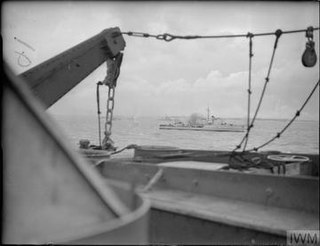
HMS Cottesmore was a Hunt-class destroyer of the British Royal Navy. The ship was built by the Scottish shipbuilder Yarrow at their Scotstoun, Glasgow shipyard in 1939–1940, being launched on 5 September 1940 and commissioning on 29 December that year.
